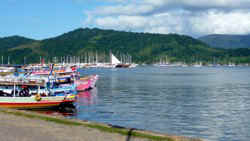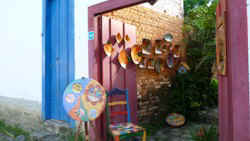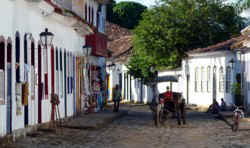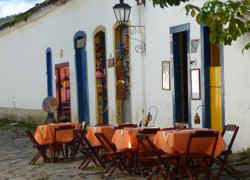

Destinations
Experiences
 |
L A
D A T C O T O U R
S |
 |
||||||||
| HOME | South America | Falkland Islands | Antarctica | Unique Destinations |
Unique Experiences |
Newsstand | ||||
|
Paraty
|
|
 |
 |
 |
 |
ABOUT PARATY - From Wikipedia, the free encyclopedia
Paraty (or Parati) [pronounced Par-a-CHEE] is a preservedProtuguese colonial (1500-1822) and Brazilian Imperial (1822-1889) town. It is located on the Costa Verde (Green Coast), a lush, green corridor that runs along the coastline of the state of Rio de Janeiro, in Brazil. Paraty has become a popular tourist area in recent years, renowned for the historic town and the coast and mountains in the region.
Geography:
The town is located on the Bay of Ilha Grande, which is dotted with many tropical islands. Rising up as high as 1,300 meters behind the town are tropical forests, mountains, and waterfalls. It is the southernmost and westernmost city in Rio de Janeiro state.Paraty is surrounded by many parks and nature preserves, including Serra da Bocaina Park, Serra do Mar State Park (of São Paulo), the Park Reserve of Joatinga and the Environmental Protection Area of Cairuçu, where the village of Trindade is located. The municipality also includes an indigenous village and an Afro-Brazilian "quilombo."
Climate:
The temperature in Paraty ranges from 60 to 97 degerees Farenheit.. Its wettest month is February. However, sea breezes temper the heat and afternoon rains are common in the summer.History:
Paraty was founded formally as a town by Portuguese colonizers in 1667, in a region populated by the Guaianás Indians. The Guaianás people who lived where the city now stands called the entire area “Paraty”. In the Tupi language “Paraty” means “river of fish”. Even today the Brazilian Mullet (Mugil Brasiliensis) still come back to spawn in the rivers that spill into the Bay of Paraty. When the region was colonized by the Portuguese, they adopted the Guaianás name for their new town.The Gold Trail:
After the discovery of the world's richest gold mines in 1696 in the mountains of Minas Gerais, Paraty became an export port for gold to Rio de Janeiro and from there on to Portugal. The ensuing gold rush led to the construction of the "Caminho do Ouro" or "Gold Trail", a 1200 kilometer road, paved in steep areas with large stones, which connected Paraty to Diamantina via Ouro Preto and Tiradentes. Not only was it was used to transport gold to Paraty, but it was also used to convey supplies, miners and African slaves by mule train over the mountains to and from the gold mining areas. Two substantial sections of the Caminho do Ouro have been excavated near Paraty and are now a popular tourist destination for hiking.The Gold Trail fell into disuse because of attacks on the gold laden ships bound for Rio de Janeiro by pirates who frequented the islands and coves of the Bay of Angra dos Reis. Eventually a safer overland route from Minas Gerais to Rio de Janeiro was created because of these pirate raids. Finally, the gold itself began to run out in the late 1700s, and Paraty declined.
The Gold Trail was submitted for inclusion on the World Heritage List in August 2004.
FROM LADATCO:
Today Paraty is a charming historic city that is not only interesting but fun. Plan to take a guided half day tour to learn the history and see the major sites. Save at least a half day just to wander around, popping in and out of the stylish boutique shops, sipping a cold drink or eating ice cream from a sidewalk cafe.
And for those with the time and inclination, there is horseback riding, biking, kayaking, schooner trips, diving and ecological trips.
Some travel tips:
- The historic district is a "walk only" area; no cars or trucks are allowed except on specified days and only to deliver goods and materials to the residents and businesses.
- Many of the "pousadas" require that you take off your shoes at the entrance and either go barefoot, use socks or special shoes provided.
- The city hustles and bustles at night - lots of restaurants and boutique stores are open.
- The cobblestone streets are very uneven - have good walking shoes.
- The drive is about 3 hours south of Rio, mostly scenic. Plan to go in the morning, do the historic tour in the afternoon, and then the day you return to Rio de Janeiro, return in the afternoon. If going and-or returning on a weekend, allow lots of extra time as traffic can be an issue.